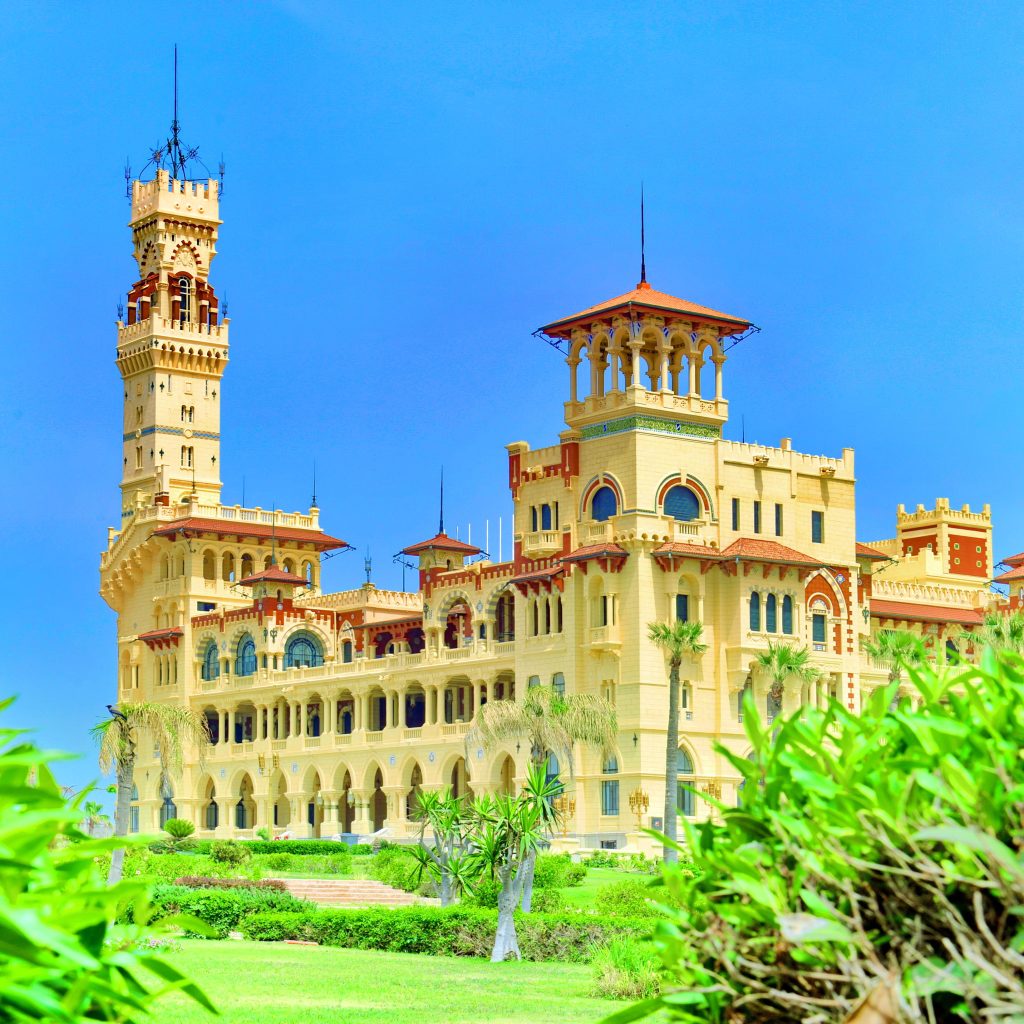Al-Montazah Palace stands as an enduring testament to the opulence and grandeur of Egypt’s royal history. With roots tracing back to the late 19th century, this architectural marvel has borne witness to the shifting tides.
History of transforming from a royal retreat into a poignant symbol of cultural heritage. In this extended exploration, we unravel the rich tapestry of Al-Montazah’s history, intricately woven into the fabric of Egypt’s regal legacy.
Birth of Al-Montazah Palace

In the year 1892, Khedive Abbas II commissioned the construction of Al-Montazah Palace, envisaging it as a summer residence for the Egyptian royal family. Positioned strategically along the Mediterranean, the palace provided a cool respite from the relentless heat of Cairo. Earning its status as an ideal haven for the ruling elite.
Architecturally, the palace was a blend of Turkish and Florentine styles, a harmonious fusion reflecting the cultural mosaic of Egypt.
Royal Residents
The halls of Al-Montazah Palace bear the echoes of a regal lineage, with its corridors having hosted Egyptian royalty since its inception. Khedive Abbas II was the inaugural resident, marking the palace’s early association with the elite rulers of Egypt.
Despite Abbas II’s exile, the palace retained its regal allure under the subsequent rule of King Fuad I, who sought refuge within its walls.
However, it was during the reign of King Farouk that Al-Montazah truly reached the zenith of royal opulence. King Farouk, renowned for his lavish and extravagant lifestyle, transformed the palace into a vibrant center of grandeur.
The corridors witnessed a tapestry of royal festivities as the king, with a penchant for the finer nuances of life. It played host to dignitaries and immersed himself in the opulent surroundings of Al-Montazah. This era marked a pinnacle in the palace’s history, solidifying its status as a symbol of regal extravagance under King Farouk’s reign.
World War II
World War II cast a profound shadow over Al-Montazah’s narrative. The tumultuous era witnessed a significant turning point in 1952 when King Farouk’s abdication unfolded, marking a pivotal moment for Egypt. The winds of change swept across the nation, steering it away from a monarchy to a republic.
This transformative shift, echoing the broader geopolitical shifts of the time, left an indelible mark on Al-Montazah. The palace, once a symbol of royal opulence, underwent a metamorphosis, shedding its identity as a royal residence to emerge as a presidential palace.
The corridors that once echoed with the footsteps of kings now adapted to a new era, embodying the evolving story of Al-Montazah in the midst of historical and political transformations.
Al-Montazah Palace Today

In the post-monarchy era, Al-Montazah Palace discovered a new purpose as a cultural and historical landmark. Presently, the palace and its verdant gardens welcome the public, offering a captivating glimpse into Egypt’s royal legacy.
The extensive grounds, adorned with fountains and statues, beckon visitors to traverse the corridors of history.
Architectural Splendor
The architectural finesse of Al-Montazah Palace stands as a testament to the craftsmanship of its time. Intricate details, from elaborate ceilings to mosaic-tiled floors, bear witness to the skill of artisans during the Belle Époque era.
The palace’s architectural design seamlessly merges with the surrounding gardens, creating an aesthetic harmony of natural and man-made beauty.
Cultural Significance
The cultural significance of Al-Montazah Palace extends far beyond its architectural splendor. Today, the palace has transformed into a vibrant cultural nucleus, playing a pivotal role in preserving and showcasing Egypt’s rich heritage.
By hosting a myriad of events, exhibitions, and cultural festivals. Al-Montazah becomes a dynamic conduit for celebrating the nation’s multifaceted history. It acts as a bridge, seamlessly connecting the past with the present, inviting visitors to immerse themselves in the captivating historical narrative of the region.
Through these cultural initiatives, the palace not only preserves its own legacy but also serves as a beacon, fostering a deeper appreciation for the diverse cultural tapestry that is woven into the fabric of Egypt’s identity.
Preservation Efforts of Al-Montazah Palace
In recent years, Al-Montazah Palace has become the focus of concerted preservation efforts. Emphasizing the importance of safeguarding its rich historical legacy. Initiatives are underway not only to maintain the palace’s structural integrity.
But also to meticulously restore its intricate details, ensuring that the essence of its culture. And historical significance endures for generations to come. Beyond bricks and mortar, the dedication to preserving the palace reflects a commitment to providing a tangible connection to Egypt’s royal past.
The meticulous care extends to the palace gardens, once witnesses to grand royal festivities. Now transformed into a carefully nurtured oasis, these gardens serve as a captivating portal, transporting visitors to a bygone era. Through these preservation endeavors, Al-Montazah Palace stands not only as an architectural marvel. But as a living testament to Egypt’s regal heritage, inviting each visitor to immerse themselves in the enchanting narrative of the past.
Visitor Experience
For contemporary visitors, Al-Montazah Palace offers a unique and immersive experience. Guided tours unfold the lives of the rulers who once graced its halls.
As one navigates through regal corridors and explores manicured gardens, the echoes of the past become tangible, offering a sensory journey through Egypt’s royal history.
Al-Montazah Palace emerges as more than a physical edifice; it is a living chronicle of Egypt’s royal heritage. From its inception as a royal retreat to its metamorphosis into a cultural landmark. The palace has withstood the sands of time.
Today, as it opens its doors to the public, Al-Montazah beckons all to witness and appreciate the grandeur of Egypt’s regal legacy. Making it an indispensable destination for those seeking a profound connection with the country’s rich history.




Comment (0)